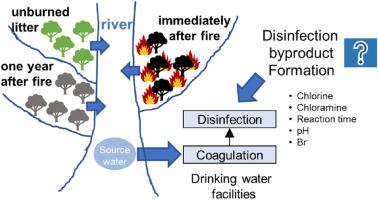Water Research ( IF 11.4 ) Pub Date : 2020-06-30 , DOI: 10.1016/j.watres.2020.116111 Huan Chen 1 , Habibullah Uzun 2 , Alex T Chow 3 , Tanju Karanfil 4

|
Wildfire could alter both the quantity and composition of terrestrial organic matter exported into source water, and water treatability of fire-impacted dissolved organic matter (DOM) could be different from its unburned counterpart. Currently, there is no standard protocol to treat wildfire-impacted source water. To identify the best treatment practices in handling post-fire runoffs, we conducted a systematic controlled study using leachates of unburned white fir (Abies concolor) and Ponderosa pine (Pinus ponderosa) and black and white ashes (collected immediately and one year after the 2013 Rim Fire, California) to evaluate coagulation and oxidation strategies for controlling disinfection byproducts (DBPs) formation. Results showed that the efficiency (%) of alum coagulation in removing dissolved organic carbon and nitrogen followed the order of litter > ash immediately after the fire > ash one year after the fire. Alum coagulation was less effectiveness in removing DOM and DBP precursors in ash leachates, compared to litter leachates. This may be attributed to the loss of side chains and the decrease of DOM molecular weight during the wildfire, thus inducing lower removal efficiency of the DOM and DBP precursors during the alum coagulation. Considering use of brominated flame retardants by firefighters, the addition of bromide (Br−) (100 μg/L) greatly increased the formation of haloacetonitriles by chlorine, and this increase was relatively lower in ash leachates. The influence of reaction time and pH on DOM reactivity was similar among the leachates of litter and ash samples. Our results show that alum coagulation followed by chloramination at alkaline pH is an effective strategy for reducing post-fire DBP formation in drinking water.
中文翻译:

野火引起的溶解有机物和消毒副产物前体的水处理效率低。
野火可能会改变出口到原水中的陆地有机物的数量和组成,并且受火影响的溶解性有机物(DOM)的水处理能力可能与未燃烧的有机物不同。当前,没有标准协议来处理受野火影响的水源。为了确定在处理后的消防径流最好的治疗实践中,我们进行使用未燃烧的白冷杉木(的渗滤液进行系统对照研究冷杉长臂猿)和黄松(黄松)和黑白灰(2013年加利福尼亚州里姆火灾之后立即收集),以评估用于控制消毒副产物(DBP)形成的凝结和氧化策略。结果表明,明矾凝结去除溶解的有机碳和氮的效率(%)的顺序为:火后立即清除垃圾>灰分>火后一年灰分。与垃圾渗滤液相比,明矾凝结法去除灰渣渗滤液中的DOM和DBP前体的效率较低。这可能归因于野火过程中侧链的丢失和DOM分子量的降低,从而导致明矾凝结期间DOM和DBP前体的去除效率降低。考虑到消防员使用溴化阻燃剂,添加溴化物(溴−)(100μg/ L)大大增加了氯形成卤代乙腈的程度,而灰分渗滤液中的这种增加相对较低。在垃圾和灰分样品的浸出液中,反应时间和pH对DOM反应性的影响相似。我们的结果表明,在碱性pH下明矾凝结然后进行氯化是减少饮用水中火后DBP形成的有效策略。











































 京公网安备 11010802027423号
京公网安备 11010802027423号